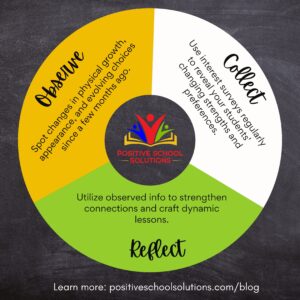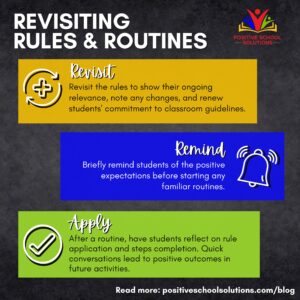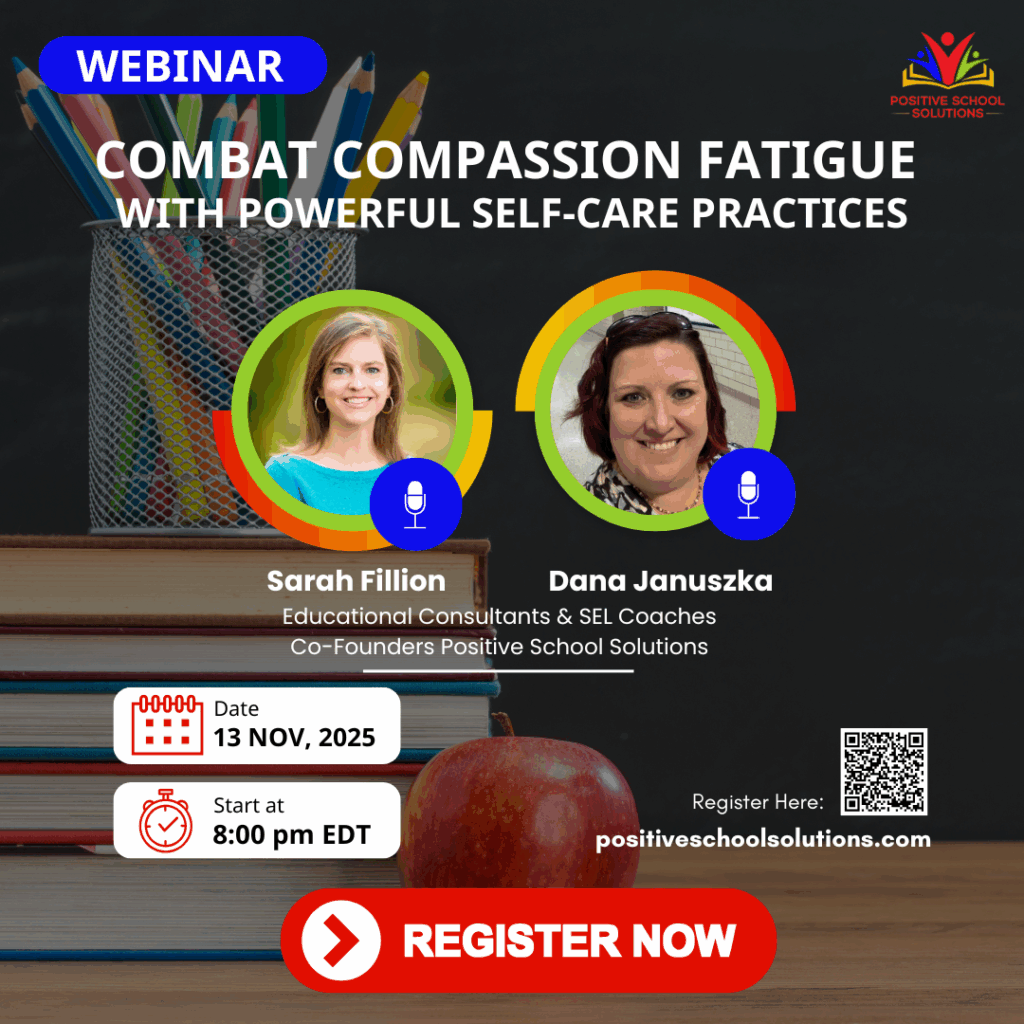By this point in the week, you and your students are back into the swing of things in school and the cobwebs developed over vacation are dusted away. Students might feel so comfortable again that you are noticing some habits you’d hoped would be left behind re-emerge. If you’re finding yourself in that situation, know that you are not alone! Read on for nine strategies that can help you reset expectations for students, while acknowledging their growth up to this point in the school year. Best of all, each strategy only takes between two and ten minutes to complete, yet will lead to positive outcomes that have much longer lasting effects.
Pause to observe, collect, and reflect on who the students in your classroom are.
- Observe. The students that entered your physical or
 virtual classroom in September have grown in many ways. Taking time to pause to observe your students will help you identify who has physically grown, which students have changed their looks, or which students are making choices that are different from their preferences only a few months ago. As you observe, note who has had a birthday so far this year and where it places them age wise in this group of students: are they older than most, the youngest, in a cluster of several students? Knowing this information can help with planning activities – knowing the ages and stages of students allows you to maximize learning opportunities through tailoring delivery and activities that align with their developmental needs.
virtual classroom in September have grown in many ways. Taking time to pause to observe your students will help you identify who has physically grown, which students have changed their looks, or which students are making choices that are different from their preferences only a few months ago. As you observe, note who has had a birthday so far this year and where it places them age wise in this group of students: are they older than most, the youngest, in a cluster of several students? Knowing this information can help with planning activities – knowing the ages and stages of students allows you to maximize learning opportunities through tailoring delivery and activities that align with their developmental needs. - Collect. Conducting periodic interest surveys to learn about your students allows you to see the new strengths and preferences they’ve developed over time. If you provided an interest survey to students at the beginning of the school year, consider using it again to see what appeals to them now and compare the two. For upper elementary or middle school students, once they have completed the newest survey, you could provide them an opportunity to compare their results and invite them to reflect on their new preferences. If this is your first time surveying students, keep it brief and open-ended, allowing students to share with you what is important to them. To get you started, we’ve attached a sample survey you can use, or you can create your own!
- Reflect. Deepening your knowledge about your students individually allows you to build better rapport with students and foster relationship-building between students, as you can see related interests that they might not be sharing aloud in class. Another critical component to knowing who your students are is knowing which students have shifted age/stage throughout the year. This time of year is a perfect opportunity to reflect on the characteristics of each age group that is represented in your classroom. For a quick reminder about developmental characteristics of students aged 4 – 14, visit this resource.
Revisit Rules and Routines
- Revisit. Revisiting the rules in the first week or two back from vacation isimportant to help students reacquaint themselves with the expectations and separate “home rules” to “school rules”. This can be done as a whole class conversation or having students work in small groups together. Depending on their age and ability, as well as the number of classroom rules you have, the conversation can include all of the rules at once or focus on one rule at a time. This discussion might be conducted throughout the day or over the span of several days. The goal of revisiting the rules is to help students see how the rules continue to apply to the learning community, identify how the rules might have changed since the beginning of the school year, and renew their agreement to the classroom rules. Some questions to use to facilitate your discussion:
- Think back to August/September when we created these rules. What are some examples of how we saw the rules alive in our learning community during writer’s workshop, science, snack, or music class?
- We have learned and grown a lot over the past 4 months together. How might our rules look different now at this point in the year, compared to the start of the year?
- Which of these rules feels easy, or natural, for you to do most of the time?
- Which of these rules do you feel is challenging to do most of the time?
- What can we do to remind ourselves to follow the rules?
- Let’s do a check-in on our rules. Thumbs up means we agree to follow these rules. Thumbs sideways means we can live with these rules. Thumbs down means we have a question or concern about one of the rules.
- Remind. Before engaging in a routine that students are familiar with, pause to remind students how the routine should be completed. You can remind the group by outlining the positive expectations such as, “Remember, when we’re transitioning from our whole group space back to our desks, we carry our chairs safely, move intentionally, and focus to make the transition efficient.” Another option is to ask a question and have students think about the response and then share with a partner or with the whole group, such as, “As we prepare for outdoor recess and lunch, I can think of 4 things each of us needs to do. See if you can think of all 4. I’ll give you 15 seconds to think, then I’ll let you know which partner you’re sharing with.”
- Apply. Once a routine or activity is completed, pause and have the students reflect on their performance regarding applying the rules or completing all steps of the routine. Engaging in a brief conversation only takes 2 – 3 minutes, however will lead to additional positive outcomes the next time routines or academic activities are completed. Below are some questions you can choose from for your reflective conversation.
- “Wow! During snack clean-up today you were all focused and ready for math in less than 2 minutes. How were we following our rules during clean up? I’ll take 3 volunteers to share.”
- “Let’s pause to reflect on our arrival routine – we’ll use the activity standing vote for this reflection. As I read one of the steps in this routine, if that one was easy to remember and complete, stand up. Sit down after that statement, but you can stand up for another if it was also easy to remember and complete.”
- Pause to review our class rules. “Think about the activity we just completed and how following the rules made the activity successful and fun for all. Turn and talk to your tent partner for 2 minutes.”
Create a balance in the day of play and purposeful practice.
- Explore. Allow students an opportunity to explore before diving into a new topic of learning. This can be done at the beginning of a unit or for a lesson that will present new content. Pose the big idea that will be covered and then give students a chance to play through exploration. Here are a few ideas to structure the exploration:
- Have students (in groups, partners, or the whole class) brainstorm things they are interested in learning about this topic. Perhaps they are familiar with the concept and have a specific area of interest or maybe they want to know more about the general idea.
- Provide some approved websites for students to visit and set a timer for 10 minutes. During that time, students are able to do some cursory research on the topic, trying to find one fact out that they can share with others.
- Create a guessing game (this works especially well for a new topic) and have the students ask yes or no questions to learn information so they can figure out what they’ll be learning about!
- Purpose. Our brains need both times of intense learning and times to relax. When you are about to engage students in intense learning, share with them the purpose behind the activity and the outcome. Communicate to students what they should be able to do at the end of the activity (in age-appropriate language), why it is important to learn, and a fun way they will be able to use this information (perhaps it is a skill FBI agents use, or maybe it is an essential skill in cooking). Sharing the purpose behind the activity sets the stage for students to engage in the activity with purpose and focus, allowing them to learn new information or refine their skills.
- Play. As mentioned in the previous bullet, our brains need periods of relaxing after intense focus and concentration. Embedding play into the day is critical in making school fun and providing opportunities for the brain to recuperate. After an academic learning activity where students were quiet and focused, consider pausing to do a movement and interactive activity. This could be a game of freeze dance, or another activity that students are comfortable with.
Each of these strategies can be used alone or in conjunction with one another to yield positive results. Structuring your day to incorporate them beyond the first few weeks of returning to school will help elevate your practice and leave you feeling renewed and hopeful. By reviewing, revising, and renewing with your students, you create a solid foundation for how the remainder of the school year will go.
Written by Sarah Fillion and Dana Januszka 2021

